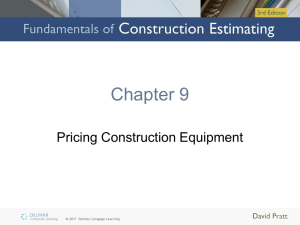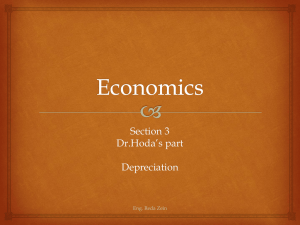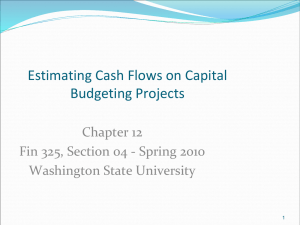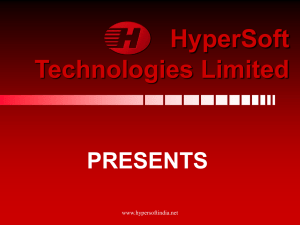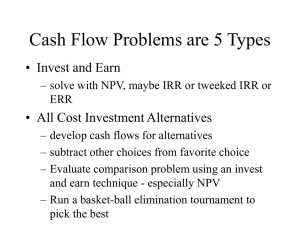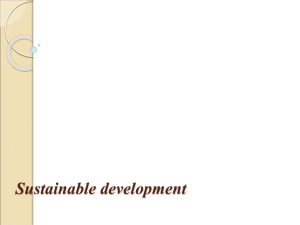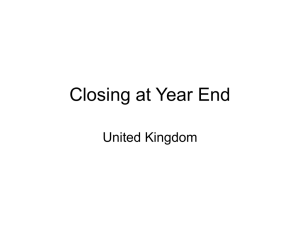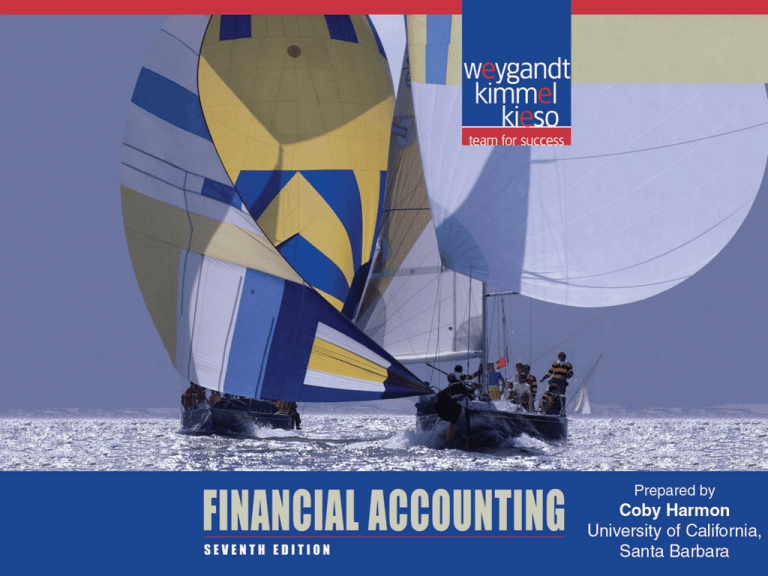
Slide
9-1
Chapter
9
Plant Assets, Natural
Resources, and
Intangible Assets (LONG TERM
ASSETS)
Financial Accounting,
Seventh Edition
Slide
9-2
In Chapter 8
You learned:
o How to account for cash and accounts
receivable
o Why it’s important to control cash
o How a company accounts for bad debts
o Types of short term receivables
Slide
9-3
Study Objectives
Slide
9-4
1.
Describe how the cost principle applies to plant assets.
2.
Explain the concept of depreciation.
3.
Compute periodic depreciation using different methods.
4.
Describe the procedure for revising periodic depreciation.
5.
Distinguish between revenue and capital expenditures, and
explain the entries for each.
6.
Explain how to account for the disposal of a plant asset.
7.
Compute periodic depletion of natural resources.
8.
Explain the basic issues related to accounting for intangible
assets.
9.
Indicate how plant assets, natural resources, and intangible
assets are reported.
In Chapter 9
You will learn:
o To account for the purchase and use of:
• Buildings
• Manufacturing plants
• Equipment
• Furniture & Fixtures
• Natural resources
• Intangible assets
o How transactions related to long-term assets
are presented on the financial statements.
Slide
9-5
Stop and Obtain the Handouts for Chapter 9
Slide
9-6
1.
To be successful in this class (and on the proctored exams),
it is important that you practice along with the PowerPoint
slides.
2.
Print out the Chapter Handouts and use to take notes along
with the slides.
3.
Stop and try to solve the practice problems, THEN check
the solution.
4.
Most students will READ and say they understand.
5.
Successful students tell us that reading is NOT enough, but
that WRITING and PRACTICING make the difference.
Plant Assets, Natural Resources, and Intangible
Assets
Plant Assets
Determining the
cost of plant
assets
Depreciation
Expenditures
during useful life
Plant asset
disposals
Slide
9-7
Natural
Resources
Intangible
Assets
Accounting for
natural resources
Accounting for
intangibles
Financial
statement
presentation
Types of
intangibles
Research and
development
costs
Statement
Presentation and
Analysis
Presentation
Analysis
Section 1 – Plant Assets
Plant assets include land, land improvements, buildings,
and equipment (machinery, furniture, tools).
Major characteristics include:
“Used in operations” and not for resale.
Long-term in nature and usually depreciated.
Possess physical substance.
Referred to as property, plant, and equipment; plant and
equipment; and fixed assets.
Slide
9-8
Section 1 – Plant Assets
Illustration 9-1
Percentages of plant assets
in relation to total assets
Slide
9-9
Determining the Cost of Plant Assets
Land
Includes all costs to acquire land and ready it for use.
Costs typically include:
(1) the purchase price;
(2) closing costs, such as title and attorney’s fees;
(3) real estate brokers’ commissions;
(4) costs of grading, filling, draining, and clearing;
(5) assumption of any liens, mortgages, or encumbrances
on the property.
Slide
9-10
SO 1 Describe how the cost principle applies to plant assets.
Acquiring Plant Assets
Assets are required to be recorded at their
Historical Cost (e.g., not appraisal value)
• Cost includes all necessary costs
to get the assets ready for their
intended purpose
• Their intended purpose is to help
generate future revenues.
• The expected future revenues
must exceed the cost of the asset.
Slide
9-11
Acquisition Cost - Land
Land
Price Paid for Land
+
+
Slide
9-12
Real Estate Commissions
Attorneys’ fees
+
Costs of preparing the
land for use, such as
clearing or draining
+
Net Cost of tearing down
existing Structures
=
Cost of Land
The Historical
Cost Remains on
the Balance
Sheet. Land is
not
depreciated
Determining the Cost of Plant Assets
Do YOU HAVE YOUR
COURSEPACK?
Calculator? If not, get
them out NOW.
Slide
9-13
SO 1 Describe how the cost principle applies to plant assets.
Determining the Cost of Plant Assets
Illustration: Assume that Hayes Manufacturing Company
acquires real estate at a cash cost of $100,000. The
property contains an old warehouse that is razed at a net
cost of $6,000 ($7,500 in costs less $1,500 proceeds from
salvaged materials). Additional expenditures are the
attorney’s fee, $1,000, and the real estate broker’s
commission, $8,000. The cost of the land is $_________
Required: Determine amount to be reported as the cost of
the land.
Slide
9-14
SO 1 Describe how the cost principle applies to plant assets.
Determining the Cost of Plant Assets
Required: Determine amount to be reported as the cost of
the land.
Land
Cash price of property of $100,000
Net removal cost of warehouse of $6,000
6,000
Attorney's fees of $1,000
1,000
Real estate broker’s commission of $8,000
8,000
Cost of Land
Slide
9-15
$100,000
$115,000
SO 1 Describe how the cost principle applies to plant assets.
Determining the Cost of Plant Assets
Land Improvements
Includes all expenditures necessary to make the
improvements ready for their intended use.
Examples are driveways, parking lots, fences,
landscaping, and underground sprinklers.
Limited useful lives.
Expense (depreciate) the cost of land improvements
over their useful lives.
Slide
9-16
SO 1 Describe how the cost principle applies to plant assets.
Acquisition Cost
Buildings - Plant
+
+
=
Slide
9-17
Price Paid for
Buildings
Costs to Update or
remodel the
facilities
Any other costs to
get the plant
operational
Cost of Building
Depreciation
allocates the
cost against
future
revenues.
Determining the Cost of Plant Assets
Buildings
Includes all costs related directly to purchase or
construction.
Purchase costs:
Purchase price, closing costs (attorney’s fees, title
insurance, etc.) and real estate broker’s commission.
Remodeling and replacing or repairing the roof, floors,
electrical wiring, and plumbing.
Construction costs:
Contract price plus payments for architects’ fees, building
permits, and excavation costs.
Slide
9-18
SO 1 Describe how the cost principle applies to plant assets.
Acquisition Cost
Building
Architects’ or
contractors’ fees
Slide
9-19
+
Construction Costs
+
Cost of renovating
or repairing building
=
Cost of Building
Buildings are
depreciated,
even if the
firm expects
the market
value of the
building to
increase
Acquisition Cost
Equipment (also Furn. & Fixt.)
Purchase Price
Slide
9-20
+
Freight-In – Cost to
have the Equipment
Delivered
+
Insurance in Transit
+
Installation Costs,
including test runs
=
Cost of Equipment
Will be
depreciated over
the estimated
useful life of the
equipment
Determining the Cost of Plant Assets
Equipment
Include all costs incurred in acquiring the equipment
and preparing it for use.
Costs typically include:
purchase price,
sales taxes,
freight and handling charges,
insurance on the equipment while in transit,
assembling and installation costs, and
costs of conducting trial runs.
Slide
9-21
SO 1 Describe how the cost principle applies to plant assets.
Determining the Cost of Plant Assets
Illustration: Assume Merten Company purchases factory
machinery at a cash price of $50,000. Related expenditures
are for sales taxes $3,000, insurance during shipping $500,
and installation and testing $1,000.
Machinery
Determine amount to be
reported as the cost of
the machinery.
Cost of Machinery
Slide
9-22
SO 1 Describe how the cost principle applies to plant assets.
Determining the Cost of Plant Assets
Illustration: Assume Merten Company purchases factory
machinery at a cash price of $50,000. Related expenditures
are for sales taxes $3,000, insurance during shipping $500,
and installation and testing $1,000. Determine amount to be
reported as the cost of the machinery.
Machinery
$50,000
Cash price
3,000
Sales taxes
Insurance during shipping
500
Installation and testing
1,000
Cost of Machinery
Slide
9-23
$54,500
SO 1 Describe how the cost principle applies to plant assets.
Let’s practice…
Slide
9-24
See Self Study Question # 1
See Brief Exercise #9-1 and 9-2
See Problem 1B
Long-Term Assets
Are recorded on the
Balance Sheet at Cost
Recording a Cost as an
Asset is called
Capitalizing the Cost
Slide
9-25
As the Assets are used….
A portion of the cost is
transferred to the Income
Statement
And Matched Against the
Revenue the assets helped
generate
Slide
9-26
Depreciation
Depreciation is the process of allocating the cost of
tangible assets to expense in a systematic and rational
manner to those periods expected to benefit from the
use of the asset.
Process of cost allocation, not asset valuation.
Applies to land improvements, buildings, and
equipment, not land.
Depreciable, because the revenue-producing ability
of asset will decline over the asset’s useful life.
Slide
9-27
SO 2 Explain the concept of depreciation.
Depreciation
Factors in Computing Depreciation
Illustration 9-6
Cost
Slide
9-28
Useful Life
Salvage Value
SO 2 Explain the concept of depreciation.
Depreciation
Depreciation Methods
Objective is to select the method that best measures
an asset’s contribution to revenue over its useful life.
Examples include:
(1) Straight-line method.
(2) Units-of-Activity method.
(3) Declining-balance method.
Illustration 9-8
Use of depreciation methods
in 600 large U.S. companies
Slide
9-29
SO 3 Compute periodic depreciation using different methods.
Depreciation
Go to your Chapter 9 – Course Pack,
Depreciation – Demo - take notes & practice!
Illustration: Barb’s Florists purchased a small delivery
truck on January 1, 2011.
Illustration 9-7
Required: Compute depreciation using the following.
(a) Straight-Line.
(b) Units-of-Activity.
(c) Declining Balance.
Slide
9-30
SO 3 Compute periodic depreciation using different methods.
First….let’s record the Journal Entry
Assume the Delivery Truck was purchased
with Cash. Note the journal entry on the
journal entry form in your handout:
General Journal – (Note: Include Explanations, put spaces between journals)
#
DATE
Account Titles AND Description
Debit
Slide
9-31
Credit
First….let’s record the Journal Entry
Assume the Delivery Truck was purchased
with Cash. Note the journal entry on the
journal entry form in your handout:
General Journal – (Note: Include Explanations, put spaces between journals)
#
DATE
Account Titles AND Description
Debit
1
1/1/2011 Equipment
Cash
To record purchase of Delivery Truck
with a 5 year life and $1,000 salvage
value.
Slide
9-32
Credit
13,000
13,000
Depreciation
Straight-Line
Expense is same amount for each year.
Depreciable cost is cost of the asset less its
salvage value.
Illustration 9-9
Slide
9-33
SO 3 Compute periodic depreciation using different methods.
Depreciation
Straight-Line Depreciation Schedule (use
your handout)
Facts:
Item: ____________________
Hint: WATCH THE DATES!
original cost:
$
13,000
salvage:
$
1,000
depreciable cost:
$
12,000
life (in years):
5
Straight - line
Column headers:
Depreciation
Expense
Accum.
Depreciation
Date of purchase
end of year
end of year
end of year
end of year
end of year
Slide
9-34
1
2
3
4
5
Book Value
$
2,400
2,400
13,000
10,600
Can you do the
other 4 years
without
checking the
answer?
SO 3 Compute periodic depreciation using different methods.
Depreciation
Can YOU do the other 4
years without checking the
answer?
Slide
9-35
SO 1 Describe how the cost principle applies to plant assets.
Depreciation (Straight-Line Method)
SOLUTION
Illustration:
Illustration 9-10
Year
Depreciable
Cost
2011
$ 12,000
2012
12,000
20
2,400
4,800
8,200
2013
12,000
20
2,400
7,200
5,800
2014
12,000
20
2,400
9,600
3,400
2015
12,000
20
2,400
12,000
1,000
2011
Journal
Entry
Slide
9-36
x
Rate
=
20%
Annual
Expense
Accum.
Deprec.
Book
Value
$ 2,400
$ 2,400
$ 10,600
Depreciation expense
Accumulated depreciation
2,400
2,400
SO 3 Compute periodic depreciation using different methods.
First….let’s record the Journal Entry using
Straight Line Method
Book depreciation for the first year, as of
12/31/2011. Add this to the journal entry
form in your handout:
General Journal – (Note: Include Explanations, put spaces between journals)
#
DATE
Account Titles AND Description
Debit
1
1/1/2011
Equipment
Cash
To record purchase of Delivery Truck
with a 5 year life and $1,000 salvage
value.
XXX
Slide
9-37
12/31/2011
Credit
13,000
13,000
Depreciation Journal Entry – Straight Line
Method
Book depreciation for the first year, as of
12/31/2011. Add this to the journal entry
form in your handout:
General Journal – (Note: Include Explanations, put spaces between journals)
#
DATE
Account Titles AND Description
Debit
1
1/1/2011
Equipment
Credit
13,000
Cash
13,000
To record purchase of Delivery Truck
with a 5 year life and $1,000 salvage
value.
XXX
12/31/2011 Depreciation Expense
Accumulated Depreciation
To book one year depreciation
expense, using straight line method.
Slide
9-38
2,400
2,400
Depreciation
Units-of-Activity
Companies estimate total units of activity to calculate
depreciation cost per unit.
In this case, the
Expense varies based on units of activity.
Depreciable cost is
cost less salvage
value.
Slide
9-39
truck’s units are its
driving range (over its
life) of 100,000 miles
SO 3 Compute periodic depreciation using different methods.
Depreciation
Units-of-Activity (use your handout)
Create a Depreciation Schedule, given the
following mileage:
•Year 1: 15,000 miles
•Year 2: 30,000 miles
•Year 3: 20,000 miles
•Year 4: 25,000 miles
•Year 5: 10,000 miles
Slide
9-40
SO 3 Compute periodic depreciation using different methods.
Depreciation
Units-of-Activity (use your handout)
Units of Activity
Depreciation
Expense
Milage
Accum.
Depreciation
Book Value
Column headers:
Date of purchase
Slide
9-41
end of year 1
15,000
end of year 2
30,000
end of year 3
20,000
end of year 4
25,000
end of year 5
10,000
$
1,800
$
1,800
$
13,000
$
11,200
$
12,000
$
0.12
per mile
$
Can1,800
you do the
other 4 years
without
checking the
answer?
SO 3 Compute periodic depreciation using different methods.
Depreciation
Can YOU do the other 4
years without checking the
answer?
Slide
9-42
SO 1 Describe how the cost principle applies to plant assets.
Depreciation (Units-of-Activity Method) SOLUTION
Units
Annual
of
Year
Activity
2011
15,000
2012
x
Unit
Depreciation Accumulated
=
Book
Expense
Depreciation
Value
$ 0.12
$ 1,800
$ 1,800
$ 11,200
30,000
0.12
3,600
5,400
7,600
2013
20,000
0.12
2,400
7,800
5,200
2014
25,000
0.12
3,000
10,800
2,200
2015
10,000
0.12
1,200
12,000
1,000
2011
Journal
Entry
Slide
9-43
Cost /
Depreciation expense
Accumulated depreciation
1,800
1,800
SO 3 Compute periodic depreciation using different methods.
First….let’s record the Journal Entry,
using Units of Activity Method
Book depreciation for the first year, as of
12/31/2011. Add this to the journal entry
form in your handout:
General Journal – (Note: Include Explanations, put spaces between journals)
#
DATE
Account Titles AND Description
Debit
1
1/1/2011
Equipment
Cash
To record purchase of Delivery Truck
with a 5 year life and $1,000 salvage
value.
XXX
Slide
9-44
12/31/2011
Credit
13,000
13,000
Depreciation Journal Entry - Units of
Activity Method
Book depreciation for the first year, as of
12/31/2011. Add this to the journal entry
form in your handout:
General Journal – (Note: Include Explanations, put spaces between journals)
#
DATE
Account Titles AND Description
Debit
1
1/1/2011
Equipment
Credit
13,000
Cash
13,000
To record purchase of Delivery Truck
with a 5 year life and $1,000 salvage
value.
XXX
12/31/2011 Depreciation Expense
Accumulated Depreciation
To book one year depreciation
expense, using units of activity method.
Slide
9-45
1,800
1,800
Depreciation
Declining-Balance
Decreasing annual depreciation expense over the
asset’s useful life.
Declining-balance rate is double the straight-line rate.
Rate applied to book value.
Illustration 9-13
Slide
9-46
SO 3 Compute periodic depreciation using different methods.
Depreciation
Can YOU do the other 4
years without checking the
answer?
Slide
9-47
SO 1 Describe how the cost principle applies to plant assets.
Depreciation (Declining-Balance Method)
SOLUTION
Illustration:
Declining
Balance
x Rate =
Annual
Deprec.
Expense
Illustration 9-14
Year
Beginning
Book value
2011
13,000
40%
2012
7,800
40
3,120
8,320
4,680
2013
4,680
40
1,872
10,192
2,808
2014
2,808
40
1,123
11,315
1,685
2015
1,685
40
12,000
1,000
2011
Journal
Entry
Slide
9-48
Accum.
Deprec.
Book
Value
$ 5,200
$ 5,200
$ 7,800
685*
Depreciation expense
5,200
Accumulated depreciation
* Computation of $674 ($1,685 x 40%) is adjusted to $685.
5,200
First….let’s record the Journal Entry,
using Declining Balance Method
Book depreciation for the first year, as of
12/31/2011. Add this to the journal entry
form in your handout:
General Journal – (Note: Include Explanations, put spaces between journals)
#
DATE
Account Titles AND Description
Debit
1
1/1/2011
Equipment
Cash
To record purchase of Delivery Truck
with a 5 year life and $1,000 salvage
value.
XXX
Slide
9-49
12/31/2011
Credit
13,000
13,000
Depreciation Journal Entry - Declining
Balance Method
Book depreciation for the first year, as of
12/31/2011. Add this to the journal entry
form in your handout:
General Journal – (Note: Include Explanations, put spaces between journals)
#
DATE
Account Titles AND Description
Debit
1
1/1/2011
Equipment
Credit
13,000
Cash
13,000
To record purchase of Delivery Truck
with a 5 year life and $1,000 salvage
value.
XXX
12/31/2011 Depreciation Expense
Accumulated Depreciation
To book one year depreciation
expense, using double declining value
method.
Slide
9-50
5,200
5,200
Depreciation
Comparison of Methods
Illustration 9-15
Illustration 9-16
Slide
9-51
SO 3 Compute periodic depreciation using different methods.
Depreciation for Partial Year
The following four slides are included to illustrate
the calculation of partial-year depreciation expense.
The amounts are consistent with the previous slides
illustrating the calculation of depreciation expense.
Slide
9-52
SO 3 Compute periodic depreciation using different methods.
Depreciation for Partial Year
Illustration: Barb’s Florists purchased a small delivery
truck on October 1, 2011.
Illustration 9-7
Required: Compute depreciation using the following.
(a) Straight-Line.
(b) Units-of-Activity.
(c) Declining Balance.
Slide
9-53
SO 3 Compute periodic depreciation using different methods.
Depreciation for Partial Year
Illustration: (Straight-line Method)
Current
Year
Expense
Year
Depreciable
Cost
2011
$ 12,000
x
20% =
$ 2,400
2012
12,000
x
20% =
2,400
2,400
3,000
2013
12,000
x
20% =
2,400
2,400
5,400
2014
12,000
x
20% =
2,400
2,400
7,800
2015
12,000
x
20% =
2,400
2,400
10,200
2016
12,000
x
20% =
2,400
1,800
12,000
Rate
Annual
Expense
Partial
Year
x
x
3/12
9/12
=
=
$
600
Accum.
Deprec.
$
600
$ 12,000
Journal entry:
2011
Depreciation expense
Accumultated depreciation
Slide
9-54
600
600
SO 3 Compute periodic depreciation using different methods.
Depreciation for Partial Year
Illustration: (Units-of-Activity Method)
Hours
x
Unit
=
Annual
Accum.
Book
Expense
Deprec.
Value
Year
Used
2011
15,000
$ 0.12
$ 1,800
$ 1,800
$ 11,200
2012
30,000
0.12
3,600
5,400
7,600
2013
20,000
0.12
2,400
7,800
5,200
2014
25,000
0.12
3,000
10,800
2,200
2015
10,000
0.12
1,200
12,000
1,000
2011
Journal
Entry
Slide
9-55
Cost /
Illustration 9-12
Depreciation expense
Accumulated depreciation
1,800
1,800
SO 3 Compute periodic depreciation using different methods.
Depreciation for Partial Year
Illustration: (Declining-Balance Method)
Declining
Balance
Rate
Annual
Expense
Partial
Year
3/12
Year
Beginning
Book Value
2011
$ 13,000 x
40%
= $ 5,200 x
2012
11,700 x
40%
=
2013
7,020 x
40%
2014
4,212 x
2015
2016
Current
Year
Expense
1,300
$ 1,300
4,680
4,680
5,980
=
2,808
2,808
8,788
40%
=
1,685
1,685
10,473
2,527 x
40%
=
1,011
1,011
11,484
1,516 x
40%
=
607
516
12,000
Plug
= $
Accum.
Deprec.
$ 12,000
Journal entry:
2011
Depreciation expense
Accumultated depreciation
Slide
9-56
1,300
1,300
SO 3 Compute periodic depreciation using different methods.
Depreciation
Depreciation and Income Taxes
IRS does not require taxpayer to use the same
depreciation method on the tax return that is used in
preparing financial statements.
IRS requires the straight-line method or a special
accelerated-depreciation method called the Modified
Accelerated Cost Recovery System (MACRS).
MACRS is NOT acceptable under GAAP.
Slide
9-57
SO 3 Compute periodic depreciation using different methods.
Depreciation
Revising Periodic Depreciation
Accounted for in the period of change and
future periods (Change in Estimate).
Not handled retrospectively.
Not considered error.
Slide
9-58
SO 4 Describe the procedure for revising periodic depreciation.
Depreciation
Illustration: Assume that Barb’s Florists decides on
January 1, 2014, to extend the useful life of the truck one
year because of its excellent condition. The company has
used the straight-line method to depreciate the asset to
date, and book value is $5,800 ($13,000 - $7,200).
Questions:
1. What is the journal entry to correct
the prior years’ depreciation?
No Entry
Required
2. Calculate the depreciation expense
for 2014.
Slide
9-59
SO 4 Describe the procedure for revising periodic depreciation.
Depreciation
Book value, 1/1/14
Salvage value
Depreciable cost
Useful life (revised)
Annual depreciation
4,800
/ 3 years
$ 1,600
Journal entry for 2014
Illustration 9-17
Depreciation expense
Accumulated depreciation
Slide
9-60
First,
establish
Book Value
at the date
of change in
estimate.
$5,800
- 1,000
1,600
1,600
SO 4 Describe the procedure for revising periodic depreciation.
Expenditures During Useful Life
Ordinary Repairs - expenditures to maintain the
operating efficiency and productive life of the unit.
Debit - Repair (or Maintenance) Expense.
Referred to as revenue expenditures.
Additions and Improvements - costs incurred to
increase the operating efficiency, productive capacity, or
useful life of a plant asset.
Debit - the plant asset affected.
Referred to as capital expenditures.
Slide
9-61
SO 5 Distinguish between revenue and capital expenditures,
and explain the entries for each.
Fraud Alert
A Revenue Expenditure reduces profit thru
an expense account (e.g., repair expense) in
the current year.
A Capital Expenditure reduces profit at a
(thru depreciation expense over time) much
slower rate
Slide
9-62
Plant Asset Disposals
Companies dispose of plant assets in three ways —
Retirement, Sale, or Exchange (appendix).
Illustration 9-18
Record depreciation up to the date of disposal.
Eliminate asset by (1) debiting Accumulated Depreciation, and
(2) crediting the asset account.
Slide
9-63
SO 6 Explain how to account for the disposal of a plant asset.
Plant Asset Disposals - Retirement
Retirement of Plant Assets
Illustration: Assume that Hobart Enterprises retires
its computer printers, which cost $32,000. The accumulated
depreciation on these printers is $32,000. The journal entry
to record this retirement is?
Accumulated depreciation
Printing equipment
32,000
32,000
Question: What happens if a fully depreciated plant asset is still
useful to the company?
Slide
9-64
SO 6 Explain how to account for the disposal of a plant asset.
Plant Asset Disposals - Retirement
Illustration: Assume that Sunset Company discards delivery
equipment that cost $18,000 and has accumulated
depreciation of $14,000. The journal entry is?
Accumulated depreciation
Loss on disposal
Delivery equipment
14,000
4,000
18,000
Companies report a loss on disposal in the “Other expenses and
losses” section of the income statement.
Slide
9-65
SO 6 Explain how to account for the disposal of a plant asset.
Plant Asset Disposals
Sale of Plant Assets
Compare the book value of the asset with the
proceeds received from the sale.
If proceeds exceed the book value, a gain on disposal
occurs.
If proceeds are less than the book value, a loss on
disposal occurs.
Slide
9-66
SO 6 Explain how to account for the disposal of a plant asset.
Plant Asset Disposals - Sale
Gain on Disposal
Illustration: Assume that on July 1, 2011, Wright Company
sells office furniture for $16,000 cash. The office furniture
originally cost $60,000. As of January 1, 2011, it had
accumulated depreciation of $41,000. Depreciation for the
first six months of 2011 is $8,000. Prepare the journal entry
to record depreciation expense up to the date of sale.
Depreciation expense
Accumulated depreciation
Slide
9-67
8,000
8,000
SO 6 Explain how to account for the disposal of a plant asset.
Plant Asset Disposals - Sale
Illustration 9-19
Computation of gain on
disposal
Illustration: Wright records the sale as follows.
July 1
Cash
16,000
Accumulated depreciation
49,000
Office equipment
Gain on disposal
Slide
9-68
60,000
5,000
SO 6 Explain how to account for the disposal of a plant asset.
Plant Asset Disposals - Sale
Loss on Disposal
Illustration 9-20
Computation of loss on disposal
Illustration: Assume
that instead of selling
the office furniture
for $16,000, Wright
sells it for $9,000.
July 1
Cash
9,000
Accumulated depreciation
Loss on disposal
Office equipment
Slide
9-69
49,000
2,000
60,000
SO 6 Explain how to account for the disposal of a plant asset.
Section 2 – Natural Resources
Natural resources consist of standing timber and
underground deposits of oil, gas, and minerals.
Distinguishing characteristics:
Physically extracted in operations.
Replaceable only by an act of nature.
Slide
9-70
SO 7 Compute periodic depletion of natural resources.
Long-Term
Assets
Expense
over time
The general term to
describe the
process is called
“Amortization”
“Depreciation” is the
specific term to describe
the amortization of
Property Plant and
Equipment
Slide
9-71
“Depletion” is the
specific term to describe
the amortization of
Natural Resources
“Amortization” is also
used to describe the
write-off of Intangible
Assets
Section 2 – Natural Resources
Cost - price needed to acquire the resource and
prepare it for its intended use.
Depletion - allocation of the cost to expense in a rational
and systematic manner over the resource’s useful life.
Depletion is to natural resources as depreciation is to
plant assets.
Companies generally use units-of-activity method.
Depletion generally is a function of the units
extracted.
Slide
9-72
SO 7 Compute periodic depletion of natural resources.
Section 2 – Natural Resources
Illustration: Assume that Lane Coal Company invests $5
million in a mine estimated to have 10 million tons of coal and
no salvage value. In the first year, Lane extracts and sells
800,000 tons of coal. Lane computes the depletion expense
as follows:
$5,000,000 ÷ 10,000,000 = $.50 depletion cost per ton
$.50 x 800,000 = $400,000 depletion expense
Journal entry:
Depletion expense
Accumulated depreciation
Slide
9-73
400,000
400,000
SO 7 Compute periodic depletion of natural resources.
Financial Statement Presentation
Illustration 9-22
Statement presentation of accumulated depletion
Extracted resources that have not been sold are reported
as inventory in the current assets section.
Slide
9-74
SO 7 Compute periodic depletion of natural resources.
Section 3 – Intangible Assets
Intangible assets are rights, privileges, and competitive
advantages that do not possess physical substance.
Intangible assets are categorized as having either a
limited life or an indefinite life.
Common types of intangibles:
Patents
Copyrights
Franchises or licenses
Slide
9-75
Trademarks and trade
names
Goodwill
SO 8 Explain the basic issues related to accounting for intangible assets.
Accounting for Intangible Assets
Valuation
Purchased Intangibles:
Recorded at cost.
Includes all costs necessary to make the intangible
asset ready for its intended use.
Internally Created Intangibles:
Generally expensed.
Only capitalize direct costs incurred in perfecting title
to the intangible, such as legal costs.
Slide
9-76
SO 8 Explain the basic issues related to accounting for intangible assets.
Accounting for Intangible Assets
Amortization of Intangibles
Limited-Life Intangibles:
Amortize to expense.
Credit asset account or accumulated amortization.
Indefinite-Life Intangibles:
No foreseeable limit on time the asset is expected to
provide cash flows.
No amortization.
Slide
9-77
SO 8 Explain the basic issues related to accounting for intangible assets.
Types of Intangible Assets
Patents
Exclusive right to manufacture, sell, or otherwise
control an invention for a period of 20 years from the
date of the grant.
Capitalize costs of purchasing a patent and amortize
over its 20-year life or its useful life, whichever is
shorter.
Expense any R&D costs in developing a patent.
Legal fees incurred successfully defending a patent
are capitalized to Patent account.
Slide
9-78
SO 8 Explain the basic issues related to accounting for intangible assets.
Accounting for Intangible Assets
Illustration: Assume that National Labs purchases a patent
at a cost of $60,000. National estimates the useful life of
the patent to be eight years. National records the annual
amortization as follows.
Amortization expense
Patent
Slide
9-79
7,500
7,500
SO 8 Explain the basic issues related to accounting for intangible assets.
Accounting for Intangible Assets
Copyrights
Give the owner the exclusive right to reproduce and
sell an artistic or published work.
plays, literary works, musical works, pictures,
photographs, and video and audiovisual material.
Copyright is granted for the life of the creator plus
70 years.
Capitalize acquisition costs.
Amortized to expense over useful life.
Slide
9-80
SO 8 Explain the basic issues related to accounting for intangible assets.
Accounting for Intangible Assets
Trademarks and Trade Names
Word, phrase, jingle, or symbol that identifies a
particular enterprise or product.
Wheaties, Game Boy, Frappuccino, Kleenex,
Windows, Coca-Cola, and Jeep.
Trademark or trade name has legal protection for
indefinite number of 20 year renewal periods.
Capitalize acquisition costs.
No amortization.
Slide
9-81
SO 8 Explain the basic issues related to accounting for intangible assets.
Accounting for Intangible Assets
Franchises and Licenses
Contractual arrangement between a franchisor and a
franchisee.
Shell, Taco Bell, or Rent-A-Wreck are franchises.
Franchise (or license) with a limited life should be
amortized to expense over the life of the franchise.
Franchise with an indefinite life should be carried at
cost and not amortized.
Slide
9-82
SO 8 Explain the basic issues related to accounting for intangible assets.
*
Franchise Facts ….
71% of Franchise owners only own one
franchise*75% have owned their Franchise for 5
years or less (43% less than 2 years)
77% work more than 40 hours per week (49% work
more than 50 hours)
65% owners are between 35-54 years old
#1 reason for buying franchise:
Seeking MORE control
What are some of the TOP franchises for 2005?
* = based on a survey of North American franchise owners representing over 200 franchises by
the Franchise Business Review, over one half million responses.
Slide
9-83
They are:
Slide
9-84
Fastest Growing Franchises…ranked
(not on exam, just an illustration)
2006
2007
2008
2009
2010
2011
2012
Stratus
Building Jan-Pro Jan-Pro
Solutions Franchisi Franchisi Hamton Hamton
Subway Subway *
ng*
ng*
Hotels
Hotels
Pizza
Hut
Jan-Pro Jan-Pro
Franchisi Franchisi
ng*
ng*
Subway Subway Subway Subway
Dunkin'
Quiznos Donuts
Source:
Stratus
Instant Building
Tax
Solutions
Jiffy
7-Eleven Lube
Subway Solutions *
* Provides cleaning
service for
commercial buildings
http://www.entrepreneur.com/franzone/fastestgro
wing/index.html
Note: Source contains
average start up costs
Slide
9-85
Accounting for Intangible Assets
Goodwill
Includes exceptional management, desirable location,
good customer relations, skilled employees, high-quality
products, etc.
Only recorded when an entire business is purchased.
Goodwill is recorded as the excess of ...
purchase price over the FMV of the identifiable net
assets acquired.
Internally created goodwill should not be capitalized.
Slide
9-86
SO 8 Explain the basic issues related to accounting for intangible assets.
Slide
9-87
Research and Development Costs
Frequently results in something that a company
patents or copyrights such as:
new product,
process,
idea,
formula,
composition, or
literary work.
All R & D costs are expensed when incurred.
Slide
9-88
SO 8 Explain the basic issues related to accounting for intangible assets.
Statement Presentation and Analysis
Presentation
Slide
9-89
Illustration 9-23
SO 9 Indicate how plant assets, natural resources,
and intangible assets are reported.
Statement Presentation and Analysis
Analysis
Illustration 9-25
Each dollar invested in assets produced $0.59 in sales. If
a company is using its assets efficiently, each dollar of
assets will create a high amount of sales.
Slide
9-90
SO 9 Indicate how plant assets, natural resources,
and intangible assets are reported.
Buying a Wreck of Your Own
There are approximately 250 million vehicles in operation in the
U.S. Around the world, there were 806 million cars and light
trucks on the road in 2007. Currently, these vehicles burn over
260 billion gallons of fuel yearly.
In the U.S., the 2008 car and light-truck market dropped
dramatically, to approximately 13.2 million units, down by about
2.9 million from 2007.
The cost of an average new car is about $22,000. The price of the
average used car is now about $13,900.
Slide
9-91
Financial institutions typically require a down payment of at least
10% of the value of a vehicle on a vehicle loan. Thus, the average
new car will require a much higher down payment. However,
interest rates on used-car loans are higher than on new-car loans.
To stimulate car sales, individuals can generally deduct fees and
taxes on the purchase price of a qualified new car, light truck,
motor home, or motorcycle.
A new car typically loses at least 30% of its value during the first
two years, and about 40 to 50% after three years. Some brands
maintain their value better than others.
To keep monthly car payments down, car companies will now
provide financing for up to six years. (It used to be two or three
years.) With such a long loan, you might end up “upside down on
the loan”—that is, you might actually owe more money than the
car is worth if you decide to sell the car before the end of the
loan.
Slide
9-92
There are many costs to
consider in deciding
whether to buy a new or
used car. These costs
include the down
payment, monthly loan
payments, insurance,
maintenance and repair
costs, and state
(department of motor
vehicle) fees. The graph
below compares the total
costs over five years for
the typical new versus
used car.
Slide
9-93
Should you buy a new car?
YES: I have enough stress in my life. I don’t want to
worry about my car breaking down—and if it does break
down, I want it to be covered by a warranty. Besides, I
have an image to maintain—I don’t want to be seen in
anything less than the latest styling and the latest
technology.
NO: I’m a college student, and I need to keep my costs
down. Also, used cars are a lot more dependable than they
used to be. In addition, my self image is strong enough that
I don’t need a fancy new car to feel good about myself
(despite what the car advertisements say).
Slide
9-94
End of Chapter 9
Slide
9-95
Good Bye and Good Luck!
Course Pack exercise solutions follow
Copyright
“Copyright © 2010 John Wiley & Sons, Inc. All rights reserved.
Reproduction or translation of this work beyond that permitted
in Section 117 of the 1976 United States Copyright Act without
the express written permission of the copyright owner is
unlawful. Request for further information should be addressed
to the Permissions Department, John Wiley & Sons, Inc. The
purchaser may make back-up copies for his/her own use only
and not for distribution or resale. The Publisher assumes no
responsibility for errors, omissions, or damages, caused by the
use of these programs or from the use of the information
contained herein.”
Slide
9-96
DEPRECIATION
Name: ___________________
On January 1, 20x1, Maynard's computer repair purchased for $50,000 a delivery truck that will be
driven an estimated 120,000 miles. The truck has an estimated useful life of five years and an
estimated residual value of $6,000. To the best of your ability, prepare a depreciation schedule.
Note: If you do not have enough information to solve a problem, put an X in the box.
Hint: WATCH THE DATES!
Straight - line
Misc. calc:
Column headers:
Cost
deprec exp
acc depre
carry. Value
Date of purchase
50,000
1
50,000
8,800
8,800
41,200
2
50,000
8,800
17,600
32,400
3
50,000
8,800
26,400
23,600
4
50,000
8,800
35,200
14,800
5
50,000
8,800
44,000
6,000
Double-Declining
Carry Value
before depre deprec exp
Rate
acc depre
Solution to
extra problem
in course pack
carry. Value
0.2
Column headers:
0.4
Date of purchase
Production
50,000
1
0.4
50,000
20,000
20,000
30,000
2
0.4
30,000
12,000
32,000
18,000
3
0.4
18,000
7,200
39,200
10,800
4
0.4
10,800
4,320
43,520
6,480
5
0.4
6,480
480
44,000
6,000
Cost
deprec exp
acc depre
carry. Value
Note: do for year
4 only. Assume
Column headers:
17,000 miles were
Date of purchase
Year 4 only
50000 driven that year.
50,000
6,233
x
x
44,000
$
0.37
6,233
Slide
9-97
note: 480 is NOT 40%
of
Slide
9-98

